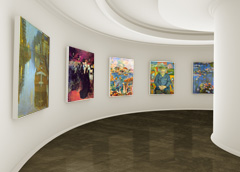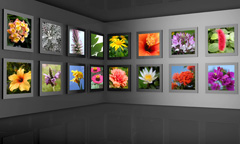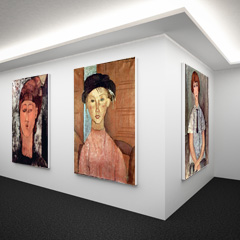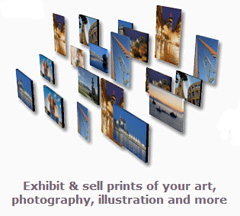| TEN TIPS FOR A GREAT ART SHOW |
 |
| Much like an actor in a play, it doesn't matter if you have headlined countless art shows or if you're just beginning to dream about your first - opening night is/will be nerve-wracking. In the midst of all the planning, promoting, organizing, and networking, it's easy to overlook important details that can make the difference between a successful show and one that leaves you questioning all your hard work.
The following article compiles ten tips from artists and curators who have been there. Whether you are a photographer, painter, sketch artist, or sculptor, being well prepared means you're bound to be pleased at the end of your exhibit.
|
SUMMARY
Ten important tips for making your first (or second, or third) art show an assured success.
| Before the Show |
During and After |
- Communicate with the Curator
- Promote, Promote, Promote
- Prepare the Art
- Gallery Preparations
- Prepare Yourself
- Ambiance
|
- Have Reasonable Expectations
- Promote Yourself
- Talk To, Not Over
- Keep Promoting
|
|
| BEFORE THE SHOW
|
 |
1. Communicate with the Curator
The curator or store owner about to show your work is probably your favorite person in the world right now. However, its important to remember they are usually generating business for themselves with your show, not just providing you a space out of the goodness of their heart. While you should still be appreciative, you need to ensure you are just as happy with the arrangement as they are.
You absolutely do not want to come to your exhibit opening unclear on any contract terms. Make sure everything has been clearly laid out - commissions, who is paying for what, your show's running time, etc. Everything should be on paper and signed by both parties. Also ensure you both have a copy of the inventory, including prices and number of pieces (if prints). This way there will be no confusion around what sold and what was never there.
Make sure you are aware of any cover charges that might exist for your show. As a general rule, artists and collectors do not like paying to walk through the door for an art show (unless you're Picasso). They might have planned to buy something because they love your work, or want to support you, and if they're already shelling out money before they've browsed, that urge to buy might be somewhat lessened. If there will be a charge, let everyone know in your promotions beforehand.
Finally, make sure anyone else who will be there in a professional capacity - the owner, their employees, or someone hired for the event - can answer some questions about you. Anyone your guests might reasonably approach should be able to say a bit about your art style, how long you've been working, and your prices.
2. Promote, Promote, Promote
Start promoting your show as early as a month in advance. Make handbills. Visit every restaurant, retail store, cafe, and library within walking distance (or farther) and ask them to put a few out for their customers. Even some public or artist-run galleries might help you get the word out. Check with the curator as well. Since your show is good for business, they will probably be doing some advertising of their own. This will expand your reach or, at the very least, let you cross a few places off your long list of promotional drop-ins.
Take to the net. Email every event announcement site that services your area, and find out if there are any local groups who promote regional events for free through social media. Check with free papers, but remember these ads often cost money. Besides the price of the handbills (which you can use during the event as well), you may not have to spend much on promotion at all. Such is the glory of the internet.
If you are utilizing an online event announcement, consider sending out multiple messages. A notification that the event is coming up three or four weeks prior, so the really dedicated recipients can pencil you in. An official invitation about ten days before the show, before most people have made solid plans for the night in question. And finally, a reminder about two days before the show, to remind those who might have forgotten. Don't spam them - make the messages colorful, fun (or suited to the show's atmosphere), and friendly. Don't expect attendance, simply extend the invitation.
3. Prepare the Art
It is usually not advisable to roll up to your exhibit set up with every single art piece you've ever created jammed in the trunk of your car. Make sure you have a clear grasp of the space's dimensions, the lengths of any short walls or recesses, even the general decor, if that applies. Then select your best pieces, preferably ones with a coherent theme. Remember: sometimes white space speaks as loudly as the art itself.
Don't just bring a bunch of originals that you've priced at hundreds of dollars apiece. While having originals around the venue is a wonderful idea, not every person who walks through the door - in fact, likely fewer than 10% of them - will be willing or able to purchase an original. Carry high quality prints of pieces you think will be popular (matting them is a great way to make them look professional), or prepare greeting or post cards that give guests on a budget a chance to own your art for less.
Once you've chosen and sorted your pieces, make sure they're safe for transit. Of course you'll want to ensure your originals are well protected, but even your prints and cards should be kept neat, in separate cellophane sleeves if possible. No matter how much or how little someone is paying, no one wants to display art with a scuff mark across the bottom or a crumpled corner.
Order Online: Easels and Displays
For more information, see our detailed articles:
4. Gallery Preparations
If there is any way you can set up the day before your show, jump at this opportunity. Not only does this save you from needing to bring a change of clothes (you never want to set up in the outfit you're wearing to the opening), but it also gives you some time to breathe. If you must set up your show only hours before, make sure you take advantage of every second.
Just in case you have the chance to set up early, be sure to have your cards ready. Every piece should include a small card listing the title, media, dimensions (HxWxD), price, and your name if you aren't the only artist in the show. Whether you are in charge of these cards or not, always look them over. Make sure the information is accurate, and everything is spelled correctly. Nothing is a bigger red flag of an unprofessional show than typos.
It may be up to the owner or curator of the space to hang your art, but you can still wander through and make sure everything is as it should be. Pieces should not be squished together on the walls, lighting should be suitably arranged for each piece, and everything must be straight. Of course, if you are showing at a cafe or retail store, it may be impossible to control factors such as lighting, but ensure your show looks as authentic and professional as possible.
Need extra hardware for your artworks? Order online:
5. Prepare Yourself
Guests at art shows don't usually have the most original questions, but that is why it's up to you to have concise and original answers prepared. Be ready to answer any or all of the questions below in the tone your show suggests, with honesty and without assuming everyone is an art critic or follows the art world minutely. In other words: keep it simple.
- When did you start painting/drawing/sculpting?
- How long did this piece take?
- What media do you use?
- Who are some of your favourite artists?
- What inspires you?
- How much time do you spend creating art?
Some artists suggest having a few good stories about each piece in their arsenal as well. If you can make the viewer feel even a little like you do about the piece they're looking at, you've upped your chances to make a sale or at least a new fan of your work.
This may sound like a small, or obvious, detail, but be sure to eat well before the show, and be well rested. It could be a long night of chatting with prospective buyers and promoting yourself like crazy, so you don't want to be dealing with a grumbling stomach or lack of sleep that could lead you to crash half way through the event.
6. Ambiance
It is generally the job of the curator/venue owner to supply the snacks for the show - wine and cheese or other simple treats. Make sure you have discussed this and know what will be there. If nothing is being offered, you must decide if this is worth the expense to you (or if the venue even allows it).
At art shows, where numerous artists are showing, it is suggested by some artists to forgo any other distractions, such as mood lighting, scents, or music - you don't want anything to take away from your products. But if your work is being featured in a solo or small group show, music is something to consider. Do you have a friend who would be willing to play violin for an hour or so, or do you want recorded music playing softly in the background. Your choices should reflect the overall feel of your art, and should not be too loud; you want to encourage conversation, not hinder it.
|



|
| DURING AND FOLLOWING THE SHOW
|
 |
7. Have Reasonable Expectations
An art show is about much more than selling your work. As a newer artist, if you manage to unload one or two originals or even a handful of prints, count yourself lucky. Don't begin plotting how to fill the newly vacated space in your studio - it's possible most of your pieces will be coming home. But your guests will be going home with the memory of your work and a card that gives them all your contact information. They can find you online or tell a friend who they know likes art similar to yours. Even if they leave your card on a cafe table, someone could pick it up and decide to wander through your show the next day.
8. Promote Yourself
Once guests have begun to file in, you need to transfer your energy from organization to communication. Mingle! Have a stack of business cards or postcard-sized bio handouts you can pass to anyone who pauses near you. Don't be afraid to approach people who are admiring your work - don't be presumptuous or try to sell them, just let them know you're around if they have any questions. Make sure they can pick you out of the crowd.
Remember networking is a two-way street. Don't just hand out cards, ask your guests if they have one of their own. Answer questions candidly, but ask questions too. What brings them here, what artists do they like, etc.
Do not leave the event. Murphy's law states the second you disappear for anything more than a bathroom break, someone wanting to buy will be looking for the artist. This is your night, but it wouldn't happen without your guests, so you should be the first one there and the last to leave. Chat briefly with existing friends and acquaintances but don't surround yourself with people you know the entire night. This event is about meeting new people.
9. Talk To, Not Over
Very few people want to buy from an artist who describes their work with onerous run-on sentences filled with jargon and technical terminology. If someone asks about your work, you may be struck with the urge to make it clear to them you are well educated and well versed in art. Unfortunately, there's a good chance they aren't. Don't scare away a prospective client or connection by becoming a thesaurus.
"I paint because I love the way the brush feels in my hand" will usually go a lot farther in continuing the conversation than something like "I paint to release the ensnared rusticity that permeates all existence in this societal milieu overwrought with contrived emotion." Even if the latter is the truth, try to find another, more tangible truth to share. Save the wordy one for your blog.
10. Keep Promoting
Once the opening night is over, your work is not complete. Get a good night's sleep, but be ready to start dealing with the results of your show. You should have a good stack of business cards to go through - add people to your social networks, follow fellow artists on Instagram and Twitter, and make a list of people who seemed interested in your art.
If you put out an email list, or originally contacted potential guests through Facebook or another invitation service, send out a thank you message. Not only will this prompt the people who came to add you to their own networks, it will also spur into action those who couldn't make it. The note will remind them your show is up for so many more days - maybe they will drop by, or at least tell some friends.
Make sure any website or page you included on your cards is up to date. This should have been done before the show, but now is a great time to prepare for what will hopefully be a great increase in traffic. Post some photos from the event, make a positive public statement about how it went, and include a message about any upcoming shows or nearly finished pieces. If you can inform your new followers while your past show is still fresh in their minds, they're more likely to note your next important date in their calendar.
|

|
| ARTIST GALLERY PROGRAM
|
 |
|
A live show in a gallery or store is a great way to interact with potential buyers and other people in the artistic community, but it can also be a lot of work. As soon as one show is finished, you must begin planning for the next. As you get more comfortable with the process it becomes less stressful, of course, but if you are working towards making a living from your art, it is always going to be a significant and time consuming part of your career.
One alternative to a live show - to complement them, not necessarily replace them - is to show your work in an online gallery. This allows you to curate your art from the comfort of your home, and offer a range of printing styles that could be difficult and costly if you had to do it all yourself. At KeenART Media, we offer a great online option for all artists who work in two dimensional media.
Our Artist Gallery Program (AGP for short) helps artists around the country display their artwork free of charge. When a visitor to the website chooses to order a print, we do all the work - we print the art, frame the paper print or gallery wrap the canvas, and ship it to the customer. In return, the artist receives a commission (a base rate plus an additional percentage of their choosing, which will affect the price of the print) for each item sold.
For more information about AGP, visit our Artist Gallery Program page. Just shoot us an email with a link to your portfolio, or some attached images, and we'll get back to you in a few days. Once you've been accepted into the program, you have full access to your gallery, with the ability to change and add images, alter prices, and start earning!
Remember, however, that much like a curator, we are primarily offering a venue. It is still up to you to make sure word gets out about your online store!
|

|
|
No matter how experienced you are at showing your work, you can always find ways to improve traffic through your show, sales, networking, and post-event results. An art show requires time and energy, but in the end it pays off - the more places you show your work, the more your name will become known, and the sooner you'll be able to fully dedicate yourself to your art.
At KeenART Media, we offer many services that could be of use to artists preparing for a gallery show:
- Don't want to bring originals? We can print and frame your gallery wrapped canvas art and have it to you in as little as a week.
- Want some professionally matted prints to offer along with your original paintings? We have a wide selection of fine art papers and many different, high quality matboards.
- Planning to sell your work but don't want to part with that special image? We offer artwork scanning so you can keep digital copies of all your originals.
- Need to frame some pieces and still make a profit? We have beautiful, high quality picture frame mouldings for a range of prices, to suit your budget and your art.
If you have any questions about our products or services, please don't hesitate to contact us. Our knowledgeable staff are always happy to offer answers and helpful suggestions or advice.
|
|

|



|
USA Giclee On Canvas, Fine Art Printing - Art Scanning & Reproductions - Handmade Oil Paintings - Custom Wood Panels, Metal Picture Framing - Block/Plaque Mountings, Large Format Dry Mounting & Lamination - Art Supplies: Stretcher Bars, Cradled Wood Panels and Artist Canvas - Collages On Canvas - Plexi/Acrylic Face Mounts - Block Acrylics, Fabric Printing, Dye Sublimation - Cityscape Skyline Prints, Resin, Photo Gifts and more...
Frame Assembly Guide - Dovetail System
USA Laser Engraving & Cutting Services
|
|
© 2002-2024 - KeenART Media Ltd.
|
|
| |
|
